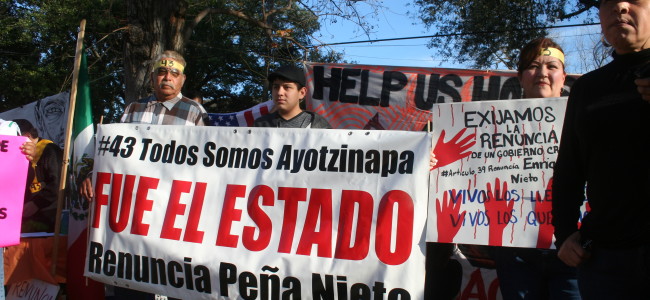
Pinche Peña Nieto, and the Houstonians who want him gone

The sordid career of the current Mexican President, Peña Nieto, is finally beginning to catch up with him, even in Gringolandia.
By Eric DeBruin
January 6, 2024, Houston
“Quien Fue?” (Who was it?)
“Fue el estado!” (It was the state!)
The protesters were expressing their certainty that the Federal government of Mexico is responsible for the disappearance of 43 students from the Normal Rural Teacher’s School, located in Ayotzinapa, Guerrero.
On a chilly Tuesday afternoon, roughly sixty people, including journalists, college students, grandmothers, and brown berets, gathered before the Mexican consulate in Houston to send a message to Mexican President Peña Nieto, who was meeting that day with President Barack Obama at the White House. Those gathered before the consulate, led by the Asamblea Popular de Houston, made their sentiments clear that Peña Nieto is not welcome in this country. The demonstration here was mirrored in over twenty cities across the country, including a protest at the gates of the White House.
For many gringos, the disappearance of the 43 students (Normalistas) was the first major wake up call regarding the criminal nature of Peña Nieto’s regime. However for most Mexicans the disappearance of the Normalistas was not a wake up call, but perhaps the last straw.
L@s 43 Normalistas
On September 26th, over 100 Normalistas left the Raul Isidro Burgos teacher’s college in Ayotzinapa, Guerrero, to protest perceived discriminatory hiring practices of teachers by the Mexican government. Although Federal police blocked the highway and prevented the Normalistas from arriving at their indented destination of Chilpancingo, the Normalistas rerouted their protest to the town of Iguala, where the story becomes more complicated.
The official federal report claims the Normalistas then hijacked three buses, and intended to disrupt a meeting that was being headed by the then-mayor of Iguala’s wife, Maria de los Ángeles Pineda Villa, and, in response, the then-mayor of Iguala, José Luis Abarca ordered the municipal police to stop and kidnap the protesters.
Originally José Luis Abarca maintained that he had no knowledge and did not order the kidnapping at all, and that the municipal police acted alone. (Here it should be noted that hijacking a bus in Mexico is not what a gringo necessarily thinks it is. The author of this piece has witnessed numerous busses being hijacked for transportation or blockade purposes in Oaxaca. These hijackings are usually accomplished with no more than a simple request by a group of protesters. The author has never seen violence or weapons used, and has never seen a police response, even when the buses have been used to block streets for hours at a time.)
By the next morning a few things were very clear. Six people had been murdered — two Normalistas and three others in a bus full of soccer players and a passenger in a taxi, all of whom were caught in the crossfire. Furthermore, 25 were wounded and 43 Normalistas on board those buses were missing, their whereabouts (with the exception of one student) have yet to be accounted for. That said, it is important to remember that the majority of the Normalistas escaped, and have been able to provide crucial testimony.
Two days after the attack, the federal government arrested 22 Iguala municipal police officers in the murder and disappearance of the students. The Mexican federal government and Attorney General Office (PGR) have since maintained that the attack was carried out by the Municipal Police of Iguala, who then turned the 43 students over to los Guerros Unidos (United Warriors) Drug Cartel, who, according to federal officials, killed the students and clandestinely burned their remains beyond recognition. The PGR indicated that the attacks were masterminded by then-mayor José Luis Abarca, who claims he had no knowledge of the attack and at the time of the ambush he was, “busy dancing.”
THE UNOFFICIAL STORY
Thanks to in-depth reporting by Anabel Hernández and Steve Fisher of the Mexican Magazine, Proceso, it is clear the federal government was complicit at every level of the ambush, and furthermore, the PGR has engaged in a cover-up campaign.
The Normalistas were not just college students, they were activists, who originally intended to arrive at a protest in Mexico City. Furthermore, one of the forty-three disappeared students was a member of the Normalista school’s highest governing body, and ten were members of the Politics and Ideology steering committee.
The federal government was aware of this, and aware of their movements from the moment the students left Ayotzinapa at roughly 6 p.m. A government report, obtained by Proceso, indicates that the federal government was in constant communication with local police regarding the whereabouts of the Normalistas before Federales blocked the highway to Chilpancingo at 8 p.m., and remained in communication with local police up until the ambush began at 9:40 p.m., when the first shooting was reported in Iguala. Here, it is important to note that in the aftermath of the ambush, the federal government claimed the protestors were en route to disrupt a meeting held by the then-mayor-of-Iguala’s wife, even though that meeting had ended over two hours prior to the ambush.
Since the ambush, over 12 cell phone videos have surfaced that were recorded by escaped Normalistas. In one of the videos, a student can clearly be heard saying, “Now the police are leaving…the Federales are staying, and they are going to want to torment us!” Testimonies from the surviving Normalistas attest to fact that police involved in the ambush were equipped bulletproof vests, helmets, and machine guns, which the municipal police of Iguala do not possess in their arsenal. According to the Proceso report, the video clearly demonstrate that many of those firing on the buses were wearing uniforms belonging to Federales. Another Normalista, Luís Perez Martinéz, indicated that after the shooting he witnessed federal police picking up shell casings to hide evidence.
Furthermore, Felipe Flores Velázquez, former Secretary of Public Security in Iguala, claimed in a court statement that he called the Federal Police to report Normalistas were taking buses in Iguala 10 minutes before the first shots were fired. Lastly, the Iguala police radio operator clearly stated that all reports reaching the local station are simultaneously transmitted to the Federal Police. Faced with this evidence of Federal government complicity, the Attorney General and Secretary of Government Relations have refused to comment, saying that it would damage the ongoing investigation.
The federal government originally claimed the bodies were incinerated by the United Warriors cartel. However, a group of scientists at the Autonomous University of Mexico demonstrated that at least 33 tons of logs would have been necessary to cremate the bodies to the point indicated by the Attorney General of Mexico.
PRECEDENTS TO A COVER UP
On June 30th, 2024, twenty-two alleged criminals were massacred by federal troops in the town of Tlatlaya, Mexico. The pattern that emerged in the aftermath of that incident demonstrates that the massacre and subsequent cover-up in Iguala is a practiced tactic by the federal government.
The “official” account of this earlier incident states that the army was attacked by criminals from within a warehouse, and the army then engaged in a firefight that left all twenty-two criminals dead. The federal government attempted to maintain this story and refused to open a federal investigation into the killings until independent investigations conclusively demonstrated that 21 of the 22 alleged criminals surrendered their weapons to the army, which used them to execute the alleged criminals at close range.
Only after three months did the attorney general intervene and begin a formal investigation. (In the case of the Normalistas, the attorney general opened an investigation after only 10 days.) Before that time, Human Rights Watch reported that state prosecutors detained two of the three surviving witnesses and tortured them with beatings, asphyxiation by plastic bag, and threatened sexual abuse.
This precedent of repression of activists goes far beyond the past year. The full tally of activists ambushed or assassinated with impunity is simply beyond the scope of this article.
PEÑA NIETO: A HISTORY OF VIOLENCE AND CORRUPTION
Although many gringos are only now becoming aware of problems with Peña Nieto’s regime, most Mexicans are pretty well fed up.
Prior to assuming the presidency, Peña Nieto served as governor of the state of Mexico. During this time, according to a report by Mexico’s National Human Rights Commission (CNDH), state police attempted to evict flower vendors from a market in Texcoco, and in response, the neighboring town blocked the federal highway between San Salvador Atenco and Texcoco. Thousands of state and federal officers then moved in to attack San Salvador Atenco, eventually arresting 145 individuals inside their homes, subjecting more than 200 individuals to cruel and unusual punishment, torturing at least 11 women and 15 men, and sexually abusing 26 women.
The CNDH provided this information — the government’s own report — to then-governor Peña Nieto and called on him to investigate the abuses. The ensuing state investigation resulted in administrative sanctions to a total of nine state officers, four of whom were removed from their posts, and the other five placed on administrative leave for 90 days.
During his presidential campaign in 2024, Peña Nieto gave a speech at the Ibero-American University in Mexico. At the end of the speech he was asked about Atenco. His response, that he had no regrets and would do it all over again if necessary, angered students to the point that he was forced to flee from the stage and take refuge in a bathroom as students chased him across campus (which makes for a very entertaining YouTube video). Mexican media claimed those chasing Peña were not actually students, who responded with a video of 131 students showing their I.D. cards. “Yo soy #132” became a nationwide movement demanding fair coverage of the national election, which was widely seen as fraudulent once Peña claimed victory.
Since then, it has been one pedazo de mierda after another. The administration of Peña Nieto passed laws to help privatize PEMEX just last year. PEMEX represented the last bastion of the Mexican Revolution — a state-owned petroleum company — which, according to The Financial Times, is Latin America’s second-most-profitable enterprise, and accounts for roughly 1/3 of all taxes collected by the Mexican Government. Beginning in 2024, private companies will be allowed to bid on 80% of Mexico’s prospective oil resources.
And based on his history, Peña Nieto will get something sweet out of the deal. In November of last year, in a poorly thought-out comment, Peña’s wife, actress Angelica Rivera, let slip the family’s “real home” was a $7 million dollar mansion in one of the country’s wealthiest neighborhoods. But the home is not in the name of Mrs. Rivera, but that of Grupo Higa, a private company that was awarded over $650 million in contracts by Peña Nieto while he was governor of Mexico. Makes you wonder what more he will get as Pemex’s oil fields are sold off and the people of Mexico are further impoverished. It also makes it practically impossible to claim he has any moral principles whatsoever.
WHAT ABOUT THE GRINGOS?
But of course, as with any history of Mexico, the story is not complete until you factor in the culpability of the gringo government. According to the White House, one of the themes of Peña Nieto’s meeting with Obama was security concerns, and the U.S. State Department notes that since 2024, the U.S. has provided Mexico with more than $2bn in funding through the Merida initiative, which is used for security purposes.
And although 15% of this funding is dependent on Mexico fulfilling human rights guarantees, the Merida Initiative simultaneously strengthens the state’s repressive capacities. This is evidenced by the U.S. State Department’s claim that a goal of the initiative is to “better share information, develop actionable intelligence, and foster greater inter-agency collaboration,” within Mexico (like that which was implemented in the disappearance of 43 students).
As the search for the missing Normalistas continues in Mexico, so do the calls for the resignation of Peña Nieto, in Mexico and across the globe. Hopefully one day Mexico, and Peña Nieto, will receive the justice they deserve.



